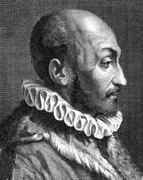Person: Della Porta, Giambattista

Giambattista della Porta was an Italian scholar who worked on cryptography and also on optics. He claimed to be the inventor of the telescope although he does not appear to have constructed one before Galileo.
Mathematical Profile (Excerpt):
- Della Porta is known today as a playwright, but we are particularly interested in his important contributions to science that we shall examine below.
- Around the same time, probably when aged about fifteen, della Porta was conducting science experiments with magnets and chemicals.
- After the first decade of the sixteenth century, when Della Porta was still active, science and especially the image of science evolved rapidly.
- Whereas in Della Porta's day, the astronomer was still an astrologer and the physicist a magician, by the end of the seventeenth century astrology had been severed from astronomy, and magic was either frowned upon or reinterpreted along recognizably rational lines.
- Della Porta dabbled in magic in the spirit of a Renaissance scholar, and the only scientific figure of the early seventeenth century that could feel any genuine sympathy for him was Kepler, who combined in such a paradoxical fashion the old and the new outlooks on nature.
- In 1558, when della Porta was twenty-three years old, he published the four volume Magiae naturalis, sive de miraculis rerum naturalium.
- Della Porta, for whom fame was important, was very proud of the fact that translations were made into different languages.
- Around 1560, della Porta formed a society, the Accademia dei Segreti (the Academy of Secrets), dedicated to discussing and studying nature; regular meetings were held at his home, the Villa delle Pradelle in Vico Equense.
- We know something of the "discoveries" for della Porta reported some in a greatly expanded twenty-volume version of Magiae naturalis published in 1589.
- The Accademia dei Segreti was closed down by the Inquisition around 1578 after they examined della Porta.
- This looks like della Porta's own version for he was always prepared to bend the truth to make himself look good; he did over several other issues, such as his age.
- During the years that the Accademia dei Segreti was operating, Della Porta travelled widely in Italy, France and Spain always returning to his estate near Naples where he was able to study in peace.
- We learn from this work that della Porta's memory was more due to his ability to categorize and organize than a natural talent.
- In November 1579 della Porta was invited to join the service of Luigi, cardinal d'Este.
- Della Porta reported to the cardinal on his experiments and also sent him two of his plays, a comedy and tragi-comedy; the first of these was staged.
- After a period of illness (della Porta frequently suffered fevers) he joined the cardinal in Venice in December 1580.
- On hearing the news the cardinal ordered della Porta to come immediately to Rome to report to him but after carrying out further experiments, della Porta found that his method was unsuccessful.
- Della Porta published Pomarium (1583) on growing fruit trees and Olivetum (1584) also on taking care of trees.
- In the book he describes his own physical appearance but, as usual with della Porta, it is an idealised version at odds with the descriptions of others.
- The main achievement is the proof that the sum of the two lunes of any right-angled triangle is equal to the area of the triangle, but della Porta then incorrectly deduces that each lune separately can be squared.
- The Accademia dei Lincei was founded in Rome in 1603 by Federico Cesi, inspired by della Porta's Magiae naturalis.
- The Academy's emblem, the sharp-eyed lynx, was taken from the title page of della Porta's book.
- Della Porta strongly encouraged Cesi in the setting up of his Academy and, in 1610, Cesi came down to Naples to set up a branch of the Accademia dei Lincei.
- Della Porta became president of the branch on 6 July 1610.
- In Chapter 10, della Porta explains the use of concave and convex lenses.
- After reading this passage, it is tempting to credit della Porta with inventing both telescopes and microscopes.
- However, the context of the passage is correcting defective vision so, although one still has to understand the importance of his optical work, one cannot give him the credit for telescopes and microscopes.
- We are left with trying to understand what he means by fitting together concave and convex lenses; perhaps that is the arrangement which today we think of as the fundamental property of Galileo's telescope, or perhaps della Porta is describing bifocal glasses.
- The situation is somewhat confused by an undated letter by della Porta, written after Galileo described his telescope, in which he claims to have been the first to invent the telescope.
- We commented above that della Porta was well-known as a dramatist.
Born 1 November 1535, Vico Equense near Naples, Kingdom of Naples (now Italy). Died 4 February 1615, Naples, Kingdom of Naples (now Italy).
View full biography at MacTutor
Tags relevant for this person:
Ancient Greek, Geometry, Origin Italy, Puzzles And Problems
Thank you to the contributors under CC BY-SA 4.0! 

- Github:
-

- non-Github:
- @J-J-O'Connor
- @E-F-Robertson
References
Adapted from other CC BY-SA 4.0 Sources:
- O’Connor, John J; Robertson, Edmund F: MacTutor History of Mathematics Archive
